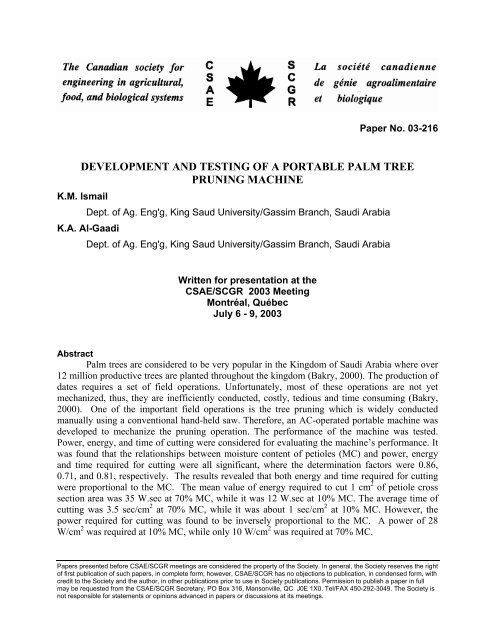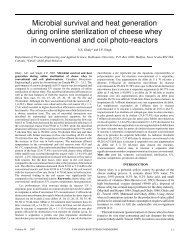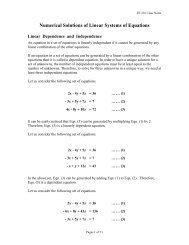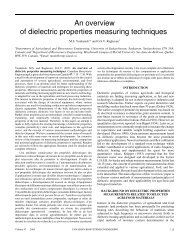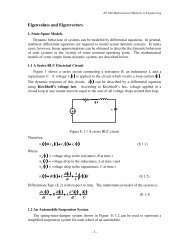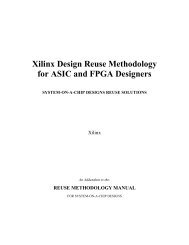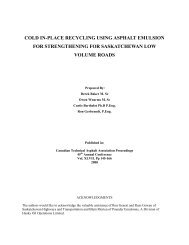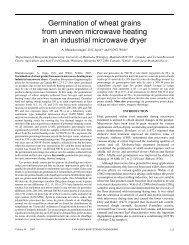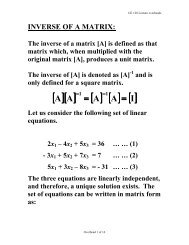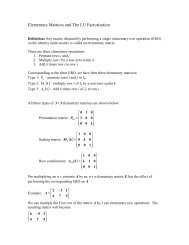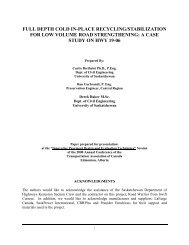development and testing of a portable palm tree pruning machine
development and testing of a portable palm tree pruning machine
development and testing of a portable palm tree pruning machine
You also want an ePaper? Increase the reach of your titles
YUMPU automatically turns print PDFs into web optimized ePapers that Google loves.
Paper No. 03-216<br />
DEVELOPMENT AND TESTING OF A PORTABLE PALM TREE<br />
PRUNING MACHINE<br />
K.M. Ismail<br />
Dept. <strong>of</strong> Ag. Eng'g, King Saud University/Gassim Branch, Saudi Arabia<br />
K.A. Al-Gaadi<br />
Dept. <strong>of</strong> Ag. Eng'g, King Saud University/Gassim Branch, Saudi Arabia<br />
Written for presentation at the<br />
CSAE/SCGR 2003 Meeting<br />
Montréal, Québec<br />
July 6 - 9, 2003<br />
Abstract<br />
Palm <strong>tree</strong>s are considered to be very popular in the Kingdom <strong>of</strong> Saudi Arabia where over<br />
12 million productive <strong>tree</strong>s are planted throughout the kingdom (Bakry, 2000). The production <strong>of</strong><br />
dates requires a set <strong>of</strong> field operations. Unfortunately, most <strong>of</strong> these operations are not yet<br />
mechanized, thus, they are inefficiently conducted, costly, tedious <strong>and</strong> time consuming (Bakry,<br />
2000). One <strong>of</strong> the important field operations is the <strong>tree</strong> <strong>pruning</strong> which is widely conducted<br />
manually using a conventional h<strong>and</strong>-held saw. Therefore, an AC-operated <strong>portable</strong> <strong>machine</strong> was<br />
developed to mechanize the <strong>pruning</strong> operation. The performance <strong>of</strong> the <strong>machine</strong> was tested.<br />
Power, energy, <strong>and</strong> time <strong>of</strong> cutting were considered for evaluating the <strong>machine</strong>’s performance. It<br />
was found that the relationships between moisture content <strong>of</strong> petioles (MC) <strong>and</strong> power, energy<br />
<strong>and</strong> time required for cutting were all significant, where the determination factors were 0.86,<br />
0.71, <strong>and</strong> 0.81, respectively. The results revealed that both energy <strong>and</strong> time required for cutting<br />
were proportional to the MC. The mean value <strong>of</strong> energy required to cut 1 cm 2 <strong>of</strong> petiole cross<br />
section area was 35 W.sec at 70% MC, while it was 12 W.sec at 10% MC. The average time <strong>of</strong><br />
cutting was 3.5 sec/cm 2 at 70% MC, while it was about 1 sec/cm 2 at 10% MC. However, the<br />
power required for cutting was found to be inversely proportional to the MC. A power <strong>of</strong> 28<br />
W/cm 2 was required at 10% MC, while only 10 W/cm 2 was required at 70% MC.<br />
Papers presented before CSAE/SCGR meetings are considered the property <strong>of</strong> the Society. In general, the Society reserves the right<br />
<strong>of</strong> first publication <strong>of</strong> such papers, in complete form; however, CSAE/SCGR has no objections to publication, in condensed form, with<br />
credit to the Society <strong>and</strong> the author, in other publications prior to use in Society publications. Permission to publish a paper in full<br />
may be requested from the CSAE/SCGR Secretary, PO Box 316, Mansonville, QC J0E 1X0. Tel/FAX 450-292-3049. The Society is<br />
not responsible for statements or opinions advanced in papers or discussions at its meetings.
1<br />
2<br />
3<br />
4<br />
5<br />
6<br />
7<br />
8<br />
9<br />
10<br />
11<br />
12<br />
13<br />
14<br />
15<br />
16<br />
17<br />
18<br />
19<br />
20<br />
21<br />
22<br />
DEVELOPMENT AND TESTING OF A PORTABLE<br />
PALM TREE PRUNING MACHINE<br />
K. M. Ismail 1 <strong>and</strong> K. A. Al -Gaadi 2<br />
1 Pr<strong>of</strong>., <strong>and</strong> 2 Assis. Pr<strong>of</strong>. at Dept. <strong>of</strong> Agric. Eng., King Saud University-Gassim, Saudi Arabia.<br />
ABSTRACT<br />
Palm <strong>tree</strong>s are considered to be very popular in the Kingdom <strong>of</strong> Saudi Arabia where over<br />
12 million productive <strong>tree</strong>s are planted throughout the kingdom (Bakry, 2000). The production <strong>of</strong><br />
dates requires a set <strong>of</strong> field operations. Unfortunately, most <strong>of</strong> these operations are not yet<br />
mechanized, thus, they are inefficiently conducted, costly, tedious <strong>and</strong> time consuming (Bakry,<br />
2000). One <strong>of</strong> the important field operations is the <strong>tree</strong> <strong>pruning</strong> which is widely conducted<br />
manually using a conventional h<strong>and</strong>-held saw. Therefore, an AC-operated <strong>portable</strong> <strong>machine</strong> was<br />
developed to mechanize the <strong>pruning</strong> operation. The performance <strong>of</strong> the <strong>machine</strong> was tested.<br />
Power, energy, <strong>and</strong> time <strong>of</strong> cutting were considered for evaluating the <strong>machine</strong>’s performance. It<br />
was found that the relationships between moisture content <strong>of</strong> petioles (MC) <strong>and</strong> power, energy<br />
<strong>and</strong> time required for cutting were all significant, where the determination factors were 0.86,<br />
0.71, <strong>and</strong> 0.81, respectively. The results revealed that both energy <strong>and</strong> time required for cutting<br />
were proportional to the MC. The mean value <strong>of</strong> energy required to cut 1 cm 2 <strong>of</strong> petiole cross<br />
section area was 35 W.sec at 70% MC, while it was 12 W.sec at 10% MC. The average time <strong>of</strong><br />
cutting was 3.5 sec/cm 2 at 70% MC, while it was about 1 sec/cm 2 at 10% MC. However, the<br />
power required for cutting was found to be inversely proportional to the MC. A power <strong>of</strong> 28<br />
W/cm 2 was required at 10% MC, while only 10 W/cm 2 was required at 70% MC.<br />
Keywords: Palm <strong>tree</strong>, <strong>pruning</strong>, energy, power, time, performance, cutting.<br />
1
1<br />
2<br />
3<br />
4<br />
5<br />
6<br />
7<br />
8<br />
9<br />
10<br />
11<br />
12<br />
13<br />
14<br />
15<br />
16<br />
17<br />
18<br />
19<br />
20<br />
21<br />
22<br />
23<br />
INTRODUCTION<br />
Palm <strong>tree</strong>s have an exceptional importance in the body <strong>of</strong> agriculture in the Kingdom <strong>of</strong><br />
Saudi Arabia. The importance comes from the fact that the <strong>tree</strong>s are widely planted all over the<br />
Kingdom for their yield <strong>of</strong> dates <strong>and</strong> for decoration purposes. Palm dates are considered to be the<br />
main fruit in Saudi Arabia supplied by 12 million <strong>palm</strong> <strong>tree</strong>s spread over an area <strong>of</strong> 106,460<br />
hectares, where the total production reaches 648,000 tons/year (Bakry, 2000). On the other h<strong>and</strong>,<br />
<strong>palm</strong> <strong>tree</strong>s, due to their durability, are commonly utilized in main s<strong>tree</strong>ts <strong>and</strong> public parks for<br />
decoration.<br />
Sial <strong>and</strong> Khalid (1983), along with Shabbana <strong>and</strong> Mohamed (1982) reported that most <strong>of</strong><br />
<strong>palm</strong> <strong>tree</strong> farms in Saudi Arabia did not follow a specific engineering regime, where <strong>palm</strong> <strong>tree</strong>s<br />
are r<strong>and</strong>omly planted <strong>and</strong> <strong>of</strong>ten inter-cropped with forage <strong>and</strong> vegetable crops <strong>and</strong>, sometimes,<br />
even permanently inter-cropped with other fruit <strong>tree</strong>s. They added that irrigation channels in<br />
these farms were not well organized causing difficulty in <strong>machine</strong> maneuvering around <strong>palm</strong><br />
<strong>tree</strong>s. Sial <strong>and</strong> Khalid (1983) stated that the traditional practice <strong>of</strong> climbing up a date <strong>palm</strong> was<br />
hazardous, time consuming <strong>and</strong> require skilled labor. Al-Kiady (2000) reported that the trained<br />
<strong>and</strong> specialized labors were becoming rare <strong>and</strong> expensive causing a serious depression in dates<br />
production. Ahmad et al. (1986) added that a new technology was not readily transferable unless<br />
major changes in the functional <strong>machine</strong> design or agricultural practices took place. That was<br />
attributed to the fact that there were major mismatches between agricultural field conditions <strong>and</strong><br />
mobilized <strong>machine</strong> specifications.<br />
Several attempts have been previously made to mechanize, on a small scale, some<br />
farming operations related to date <strong>palm</strong> <strong>tree</strong>s. Brown (1982) stated that mechanization <strong>of</strong> dates<br />
production was essential due to the scarcity <strong>and</strong> high cost <strong>of</strong> labor. He developed a hydraulic<br />
2
1<br />
2<br />
3<br />
4<br />
5<br />
6<br />
7<br />
8<br />
9<br />
10<br />
11<br />
12<br />
13<br />
14<br />
15<br />
16<br />
17<br />
18<br />
19<br />
20<br />
21<br />
22<br />
23<br />
lifter to reach the <strong>palm</strong> <strong>tree</strong> top for easier harvesting. His lifter, as he reported, reduced the<br />
required labor by 80 percent <strong>and</strong> related cost by 50 percent. Abdalla et al. (1986) developed a<br />
simple <strong>and</strong> inexpensive walk-up elevator to suit date farming operations. The elevator consisted<br />
<strong>of</strong> a single beam with two walking up feet pedals <strong>and</strong> a seat. The elevator was designed where a<br />
worker can lift himself up by pedaling <strong>and</strong> then sits when reaching the crown zone to perform<br />
required operations. Omar et al. (1986) modified two lifts to be utilized in <strong>palm</strong> <strong>tree</strong> crownrelated<br />
operations, such as pollination, <strong>pruning</strong> <strong>and</strong> harvesting. One lift was one man operated<br />
called ‘Ben-10’, while the other was an aerial lift platform called ‘Palmates’. Modifications were<br />
necessary for the improvement <strong>of</strong> traction capability, working height <strong>and</strong> <strong>machine</strong><br />
maneuverability. The modified two lifts were found to perform satisfactorily under <strong>palm</strong> <strong>tree</strong><br />
field conditions. Ahmad (1994) developed a mechanical elevator that could easily move through<br />
<strong>palm</strong> <strong>tree</strong>s <strong>and</strong> safely put labors at the <strong>tree</strong> crown level to perform desired operations. The<br />
elevator had to be equipped with a motor to improve its performance.<br />
A non-scientific trial was made by Bahdal (2002) where he developed a saw for <strong>pruning</strong><br />
<strong>palm</strong> <strong>tree</strong>s. No tests for this saw were reported. However, it seems that the saw is not powerful<br />
enough to perform heavy-duty jobs.<br />
The above literature shows the necessity <strong>of</strong> exerting more efforts to mechanize <strong>palm</strong> <strong>tree</strong><br />
farm operations. Thus, the objectives <strong>of</strong> this paper were to develop a new <strong>portable</strong> <strong>machine</strong> to<br />
perform <strong>palm</strong> <strong>tree</strong> <strong>pruning</strong> operation <strong>and</strong> test its performance.<br />
MACHINE DESCRIPTION<br />
The developed <strong>portable</strong> <strong>pruning</strong> <strong>machine</strong> shown in Fig. 1 <strong>and</strong> 2 was designed so it could<br />
be carried around by one person. Thus, the total weight <strong>and</strong> size <strong>of</strong> the <strong>machine</strong> were carefully<br />
considered in its design, where the weight <strong>and</strong> length were maintained at 7 kg <strong>and</strong> 130 cm,<br />
3
1<br />
2<br />
3<br />
4<br />
5<br />
6<br />
7<br />
Figure 1: The developed <strong>portable</strong> <strong>palm</strong> <strong>tree</strong> <strong>pruning</strong> <strong>machine</strong><br />
8<br />
9<br />
10<br />
11<br />
48 61 24<br />
54 52.5<br />
H<strong>and</strong>le, 3.5D 12<br />
15<br />
Saw, 18D, 60 teeth<br />
12<br />
13<br />
14<br />
Rotating Shaft, 0.9D<br />
2.5<br />
Spring<br />
21 9<br />
15<br />
16<br />
Motor<br />
2.5 D<br />
ELEVATION VIEW<br />
Bearing<br />
Holding Tip<br />
17<br />
18<br />
90<br />
Diff. Gears<br />
19<br />
105<br />
20<br />
21<br />
PLAN VIEW<br />
Dimensions in centimeters<br />
22<br />
Figure 2: Elevation <strong>and</strong> plan views <strong>of</strong> the developed <strong>pruning</strong> <strong>machine</strong>.<br />
4
1<br />
2<br />
3<br />
4<br />
5<br />
6<br />
7<br />
8<br />
9<br />
10<br />
11<br />
12<br />
13<br />
14<br />
15<br />
16<br />
17<br />
18<br />
19<br />
20<br />
21<br />
22<br />
23<br />
respectively. The <strong>machine</strong> was composed <strong>of</strong> an AC-operated drill motor with a power <strong>of</strong> 1200<br />
W at 2400 rpm which was readily available in the local market. The motor was utilized to<br />
provide the mechanical energy from the electrical energy. Connected to the motor was a one<br />
meter long rotating shaft with a diameter <strong>of</strong> 0.9 cm. The shaft was used to transfer the motor's<br />
rotational motion at one end to a couple <strong>of</strong> differential gears, pinion connected to the shaft <strong>and</strong><br />
crown connected to a cutting saw, at the other end. The functions <strong>of</strong> the gears were to convert the<br />
horizontal shaft motion into a vertical motion <strong>and</strong> reduce its rotational speed before it was<br />
supplied to the saw. Reduction <strong>of</strong> the speed was performed to increase the cutting torque on the<br />
saw <strong>and</strong> was obtained by employing a 10 teeth, 3 cm radius pinion gear engaged with a 16 teeth,<br />
4 cm crown gear. Thereby, the speed <strong>of</strong> the shaft was reduced by a ratio <strong>of</strong> 1.6 resulting in a saw<br />
rotational speed <strong>of</strong> 1500 rpm at no load. A circular saw <strong>of</strong> 60 teeth <strong>and</strong> 18 cm diameter was<br />
employed as the cutting component driven by the gears. Mounting bearings <strong>and</strong> the cutting saw<br />
axis were carried by a frame composed <strong>of</strong> two parallel protection bars. In order to reduce<br />
<strong>machine</strong> vibration <strong>and</strong> increase its stability during cutting operation, a 9 cm long tip was mounted<br />
on the frame to function as a side supporter. A spring inside a metal tube was utilized to place a<br />
force sufficient to inject part <strong>of</strong> the tip into the petiole required to be cut. Thereby, big portion <strong>of</strong><br />
the <strong>machine</strong>’s weight would be carried by the tip <strong>and</strong> stability <strong>of</strong> the <strong>machine</strong> would be increased<br />
because the <strong>machine</strong> would be held by the <strong>tree</strong> through the tip. For safety purposes, a plastic<br />
wrap was used to cover the moving parts close to the operator.<br />
MACHINE'S PERFORMANCE EVALUATION<br />
The <strong>machine</strong>'s performance evaluation was designed to reveal the behavior <strong>of</strong> the<br />
<strong>machine</strong> in terms <strong>of</strong> its consumption <strong>of</strong> electrical power <strong>and</strong> time required to cut one unit <strong>of</strong> a<br />
petiole's cross section area (cm 2 ) at a predetermined petiole's moisture content (MC.) The time<br />
5
1<br />
2<br />
3<br />
4<br />
5<br />
6<br />
7<br />
8<br />
9<br />
10<br />
11<br />
12<br />
13<br />
14<br />
15<br />
16<br />
17<br />
<strong>and</strong> power measurements were utilized to compute the energy required for cutting. Power, time<br />
<strong>and</strong> energy were determined to be the dependent variables <strong>and</strong> were functions <strong>of</strong> the petiole<br />
sample MC. Four different MC levels with 20 replicates each were obtained by subjecting fresh<br />
green samples <strong>of</strong> petioles to different periods <strong>of</strong> natural drying <strong>and</strong> then placing them in a drying<br />
oven for complete drying. For each MC level, 20 cuts were performed to form 20 replicates <strong>of</strong><br />
one MC level. During cutting operations, petiole samples were safely fixed horizontally on a<br />
special arrangement designed for this purpose. The arrangement carrying the sample was<br />
connected to a spring that was utilized to ensure that the sample was steadily held against <strong>and</strong><br />
constantly fed to the cutting edge.<br />
Determination <strong>of</strong> petiole moisture content (MC)<br />
The determination <strong>of</strong> petiole moisture contents was conducted on the wet basis using the<br />
st<strong>and</strong>ard methods reported by Rygg (1948) <strong>and</strong> Ismail (2003). Samples were weighed before<br />
oven drying using an electrical scale (LIBROR EB-4000H; model:1410D) <strong>of</strong> 0.01g accuracy.<br />
For complete drying, the samples were placed for 48 hours in a vacuum oven (Sheldon<br />
Manufacturing Inc., USA) at a temperature <strong>of</strong> 65 o C <strong>and</strong> a vacuum <strong>of</strong> 762 mm Hg. The samples<br />
were again weighed <strong>and</strong> MC% was calculated using the following formula:<br />
WW<br />
MC, % = *100<br />
(1)<br />
W<br />
T<br />
18<br />
where:<br />
W W = weight <strong>of</strong> removed water,<br />
19<br />
W T =<br />
total weight <strong>of</strong> sample before oven drying.<br />
20<br />
21<br />
22<br />
Power measurement<br />
A power measuring device (WSE, LVM210) shown in Fig. 3 was used to measure the<br />
electrical power required by the <strong>machine</strong> to perform cutting <strong>of</strong> different petiole samples (different<br />
6
1<br />
2<br />
3<br />
moisture contents). The device was specified to have a capacity <strong>of</strong> 4000 W with an accuracy <strong>of</strong><br />
±0.5%. A stop watch was used to determine the time, in seconds, consumed in cutting. Energy<br />
was calculated by multiplying the power measurement by the time consumed in petiole cutting.<br />
4<br />
Figure 3: The experimental setup used for <strong>testing</strong> the developed <strong>machine</strong><br />
5<br />
6<br />
7<br />
8<br />
9<br />
10<br />
11<br />
12<br />
13<br />
14<br />
15<br />
16<br />
Calculation <strong>of</strong> petiole cross-section area<br />
For each cut (each replicate) the cross section area resulting from cutting was depicted on<br />
a paper to obtain the actual exact shape <strong>and</strong> boundaries <strong>of</strong> the cut area on a sample. A computer<br />
program was designed to calculate the area <strong>of</strong> the depicted shapes utilizing MATHCAD s<strong>of</strong>tware.<br />
The program used scanned images <strong>of</strong> the depicted shapes <strong>and</strong> computed the number <strong>of</strong> pixels<br />
contained by the shapes. Through a calibration known area in cm 2 , the program conducted a<br />
comparison <strong>and</strong> calculated the area <strong>of</strong> the scanned irregular shapes.<br />
RESULTS AND DISCUSSION<br />
The results <strong>of</strong> the performance tests are shown on Fig. 4, 5, <strong>and</strong> 6. Fig. 4 shows that the<br />
power required for cutting is inversely proportional to the petiole MC. The determination factor<br />
(R 2 ) <strong>of</strong> this relationship was found to be 0.86 suggesting a linear relationship between the two<br />
7
Cutting Power, W/cm 2<br />
40<br />
35<br />
30<br />
25<br />
20<br />
15<br />
10<br />
5<br />
0<br />
R 2 = 0.86<br />
0 20 40 60 80<br />
Moisture Content, %<br />
1<br />
Figure 4: Effect <strong>of</strong> petiole moisture content on cutting power.<br />
Mean cutting time, sec/cm 2<br />
5<br />
4.5<br />
4<br />
3.5<br />
3<br />
2.5<br />
2<br />
1.5<br />
1<br />
0.5<br />
0<br />
R 2 = 0.81<br />
0 20 40 60 80<br />
Moisture Content, %<br />
2<br />
Figure 5: Effect <strong>of</strong> petiole moisture content on cutting time.<br />
Mean Energy, W.sec/cm 2<br />
50<br />
40<br />
30<br />
20<br />
10<br />
0<br />
R 2 = 0.71<br />
0 20 40 60 80<br />
Moisture Content, %<br />
3<br />
4<br />
Figure 6: Effect <strong>of</strong> petiole moisture content on energy required for cutting.<br />
8
1<br />
2<br />
3<br />
4<br />
5<br />
6<br />
7<br />
8<br />
9<br />
10<br />
11<br />
12<br />
13<br />
14<br />
15<br />
16<br />
17<br />
18<br />
19<br />
20<br />
21<br />
22<br />
23<br />
variables. The regression model is indicated in equation 2. As shown, the cutting power required<br />
for fresh petioles (60-75% MC) is 12 W/cm 2 while it is 27 W/cm 2 at more dry petioles (about<br />
17% MC).<br />
P = 32.17 − 0.3145 MC, R<br />
2 = 0.86<br />
(2)<br />
where: MC= petiole moisture content, %<br />
P= power required to cut 1 cm 2 <strong>of</strong> petiole cross section area (W).<br />
Fig. 5 shows that the required time <strong>of</strong> petiole cutting is proportional to the petiole MC.<br />
The R 2 <strong>of</strong> this relationship was found to be 0.81 suggesting a linear relationship. The regression<br />
model is indicated in equation 3. As shown in Fig. 5, the fresh cut petioles <strong>of</strong> 60 to 75% MC<br />
required a cutting time <strong>of</strong> at least 3 sec/cm 2 while the dried cut petioles <strong>of</strong> 5 to 15% MC required<br />
about 0.9 sec/cm 2 . Clearly, the fresh cut petioles required more time than the dried ones. This is<br />
attributed to the fact that moisture makes petiole fibers stronger <strong>and</strong> more tied to each other.<br />
Thus, the petiole becomes more resistant to cutting.<br />
T = 0.4187 + 0.0432 MC, R<br />
2 = 0.81<br />
(3)<br />
where: T= time required for cutting (sec/cm 2 ),<br />
MC= petiole moisture content, %.<br />
Figure 6 shows that the energy required for cutting is proportional to the petiole MC.<br />
Obviously, increasing petiole moisture content increased the cutting energy due to increasing<br />
cutting time. Again, the fresh petioles <strong>of</strong> 60 to 75% MC required a cutting energy <strong>of</strong> 30 to 35<br />
W.sec/cm 2 , while the dried petioles <strong>of</strong> 5 to 15% MC required 12 to 15 W.sec/cm 2 . The R 2 value<br />
<strong>of</strong> the relationship was 0.71 suggesting a linear relationship. The regression model is indicated in<br />
equation 4.<br />
E = 7.13 + 0.399 MC, R<br />
2 = 0.71<br />
(4)<br />
9
1<br />
2<br />
3<br />
4<br />
5<br />
6<br />
7<br />
8<br />
9<br />
10<br />
11<br />
12<br />
13<br />
where: E= energy required for cutting, W.sec/cm 2 ,<br />
MC= petiole moisture content, %.<br />
SUMMARY AND CONCLUSIONS<br />
A <strong>machine</strong> was developed in order to mechanize the <strong>pruning</strong> operation <strong>of</strong> <strong>palm</strong> <strong>tree</strong>s<br />
where it is thought that the manual conventional way <strong>of</strong> performing the operation is costly,<br />
tedious <strong>and</strong> time consuming (Bakry, 2000). The performance tests <strong>of</strong> this <strong>machine</strong> showed that<br />
the <strong>machine</strong> could be efficiently used for <strong>pruning</strong> <strong>palm</strong> <strong>tree</strong>s. Results showed that the required<br />
cutting power was 10 <strong>and</strong> 28 W/cm 2 for the fresh cut petioles <strong>of</strong> about 70% moisture content<br />
(MC) <strong>and</strong> the dried cut petioles <strong>of</strong> about 10% MC, respectively. Time required for cutting was<br />
3.5 sec/cm 2 for the fresh cut petioles <strong>of</strong> about 70% MC, while it was 0.9 sec/cm 2 for the dried cut<br />
petioles <strong>of</strong> about 10% MC. In addition, the mean energy required for cutting petioles was 35<br />
W.sec/cm 2 for the fresh cut petioles <strong>of</strong> 70% MC, while it was 12 W.sec/cm 2 for the dried cut<br />
petioles <strong>of</strong> about 10% MC.<br />
14<br />
15<br />
16<br />
17<br />
18<br />
ACKNOWLEDGMENT<br />
The authors would like to express their thanks to Dr. Ahmad Al-Shooshan in the<br />
department <strong>of</strong> Agric. Eng., College <strong>of</strong> Agriculture for his great <strong>and</strong> valuable help in designing the<br />
computer program used to calculate the petioles cross section areas.<br />
19<br />
20<br />
21<br />
22<br />
23<br />
24<br />
25<br />
10
1<br />
REFERENCES<br />
2<br />
3<br />
4<br />
5<br />
6<br />
7<br />
8<br />
9<br />
10<br />
11<br />
12<br />
13<br />
14<br />
15<br />
16<br />
17<br />
18<br />
19<br />
20<br />
21<br />
22<br />
23<br />
24<br />
25<br />
26<br />
27<br />
28<br />
29<br />
30<br />
31<br />
32<br />
33<br />
34<br />
35<br />
36<br />
37<br />
38<br />
Abdalla, K. N., O.S. Hassan <strong>and</strong> A.E. Ahmed. 1986. Development <strong>of</strong> a walk elevator to<br />
suit date Palms farming operations. The second symposium on dates Palm in Saudi<br />
Arabia, King Faisal University, Saudi Arabia. March 1986.<br />
Ahmed E. A., O.S. Hassan <strong>and</strong> M. M. Khalil. 1986. Surveying <strong>of</strong> some date <strong>palm</strong><br />
parameters <strong>and</strong> properties to be utilized in date <strong>palm</strong> production <strong>development</strong>. The<br />
second symposium on dates Palm in Saudi Arabia, King Faisal University, Saudi Arabia.<br />
March 1986.<br />
Al-Kiady, H. K. 2000. Date <strong>palm</strong> <strong>tree</strong> (processing <strong>and</strong> agricultural technologymechanical<br />
<strong>and</strong> harvesting <strong>of</strong> dates). Pub.:Dar Zahran. Oman.<br />
Bahdal, A.R. 2002. Date <strong>tree</strong> saw. Al-Riyadh Newspaper. November, 22 2002.<br />
Bakry, H. 2000. Engineering views <strong>of</strong> date processing. A lecture in the first workshop on<br />
dates production. The chamber <strong>of</strong> commerce in Gassim, Saudi Arabia. September, 2003.<br />
Brown, G.K. 1982. Date production mechanization in the USA. The first symposium on<br />
date <strong>palm</strong> in Saudi Arabia, Al-Ahsa, pp:2-13.<br />
Ismail, K.M. 2003. Optimum method for estimating the moisture content <strong>of</strong> <strong>palm</strong> <strong>tree</strong>s<br />
petioles. Under publication.<br />
Omar, A.H., F.S. Sial, A.E. Ahmed <strong>and</strong> K.N. Abdalla. 1986. Modification <strong>of</strong> some<br />
industrial equipment to suit date <strong>palm</strong> orchards mechanization. The first symposium on<br />
date <strong>palm</strong> in Saudi Arabia, Al-Ahsa, pp.:543-554.<br />
Rygg, G.L. 1948. Storage humidity for dates. Annual Rep. Date Growers’ Inst., 25:34-<br />
35.<br />
Sial, F.S. <strong>and</strong> M. Khalid. 1983. Appropriate date mechanization technology for Arabian<br />
Oasis. ASAE paper No. 83-1570. St. Joseph, MI: ASAE.<br />
Sohaibani, S. <strong>and</strong> A. Babaeer. 1991. Field tests <strong>of</strong> the KSU date <strong>palm</strong> service <strong>machine</strong>.<br />
Arabic Gulf Journal <strong>of</strong> Scientific Research. 9(3):55-73.<br />
39<br />
40<br />
41<br />
11


